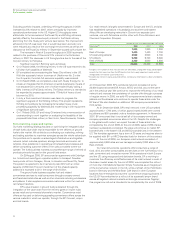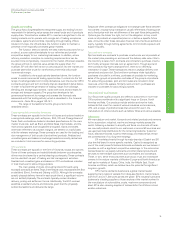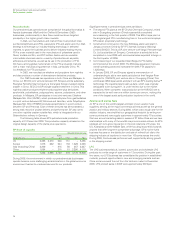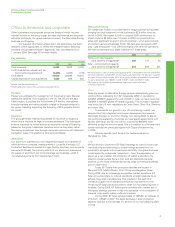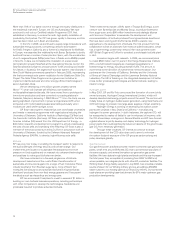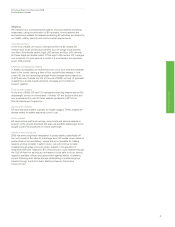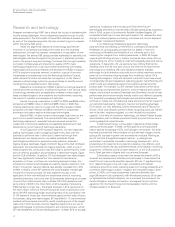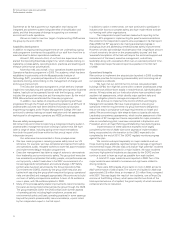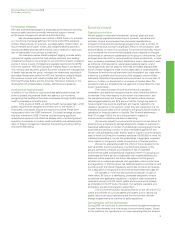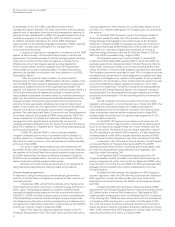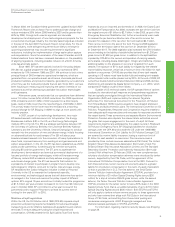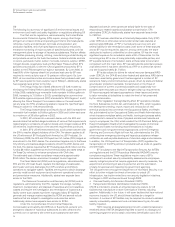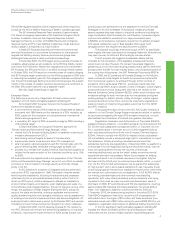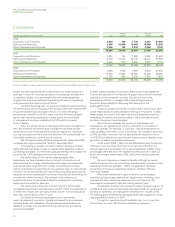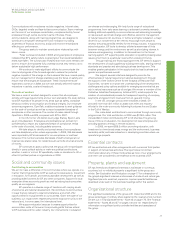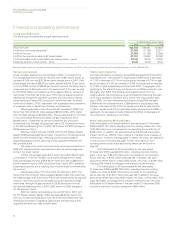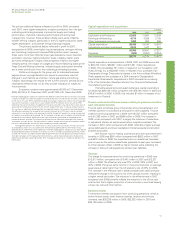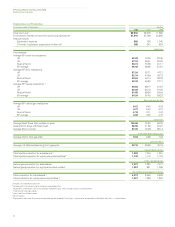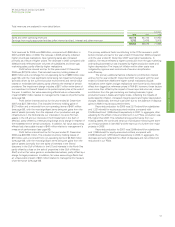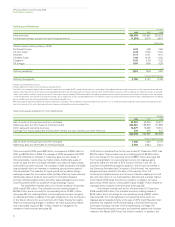BP 2008 Annual Report Download - page 45
Download and view the complete annual report
Please find page 45 of the 2008 BP annual report below. You can navigate through the pages in the report by either clicking on the pages listed below, or by using the keyword search tool below to find specific information within the annual report.
BP Annual Report and Accounts 2008
Performance review
by certification to the ISO 14001 international environmental
management system standard. The Texas City refinery, after completing
planned work to strengthen its environmental management systems, is
planning to seek recertification in 2009. Our Angola business is working
towards an expansion of its existing ISO 14001 certificate to include
its offshore production facilities by the end of 2009. Progressive
implementation of the Operating Management System (OMS), including
ISO 14001, will also help us strengthen our management of
environmental performance.
In support of ongoing risk management, one element of the OMS
applies, at least annually, a formal systematic process to identify and
assess risks; this process provides to identify emerging issues including
those with an environmental impact. To assist us in measuring the
effectiveness of our risk mitigation actions we have established
environmental metrics, which are available within BP Sustainability
Report 2008, at www.bp.com/sustainability. The 2008 information is
planned to be available in conjunction with the publication of our 2008
Sustainability Report.
After two years of implementation, our Environmental
Requirements for New Projects (ERNP) practice has been updated in line
with the OMS. We have simplified applicability, clarified the governance
process and updated the text to reflect organizational changes. This
practice, now called the Environmental Group Defined Practice (GDP) is a
full life cycle environmental assessment process. It requires all new
major projects and projects in sensitive areas, to undertake screening to
determine the potential environmental sensitivities associated with the
proposed projects. Requirements and project recommendations now
extend to include appropriate considerations for decommissioning of
assets. A new project with the highest level of environmental sensitivity
requires more rigorous and specific environmental management
activities. The board-appointed Safety, Environment and Ethics Assurance
Committee reviewed the progress of ERNP during summer 2008. This
review included the 12 projects that have been classified as requiring
management at the highest level of sensitivity. We are currently
integrating social considerations into the Environmental GDP and plan to
issue this in 2009 as an integrated set of requirements addressing social
and environmental issues.
In 2008, BP used the ERNP to review risks and establish
mitigation measures prior to entry in connection with the decision to
develop adjacent to a Protected Area at Hamble Oil Terminal in the UK.
We intend to make a summary of the risk assessment publicly available
at the end of April 2009.
Our focus on asset decommissioning is demonstrated by the
North West Hutton offshore platform project in the North Sea. 2008 saw
the topsides of the North West Hutton platform safely brought onshore
for further dismantling. This decommissioning is expected to result in
20,000 tonnes of recycled steel, in line with our aim to have 97% of the
decommissioned materials recycled and/or reused.
We seek to limit the environmental impact of our operations by
using resources responsibly and reducing waste and emissions.
Climate change programmes
In response to rising concerns about climate change, governments
continue to identify fiscal and regulatory measures at local, national and
international levels.
In December 1997, at the Third Conference of the Parties to the
United Nations Framework Convention on Climate Change (UNFCCC) in
Kyoto, Japan, the participants agreed on a system of differentiated
international legally-binding targets for the first commitment period of
2008-2012. In 2005, the Kyoto protocol came into force, committing the
176 participating countries to emissions targets. However, Kyoto was
only designed as a first step and policymakers continue to discuss what
new agreement might follow it after 2012, most recently at the UNFCCC
conference in Poznan, Poland in December 2008.
Many of our larger EU stationary assets are subject to the EU
Emissions Trading Scheme (EU ETS), which was extended to Norway by
reciprocal agreement. After inclusion of our Norwegian assets, around
one-fifth of our reported 2008 global CO2 emissions are now covered by
this scheme.
At the March 2007 European Council, the European Heads of
Government decided to adopt their Climate Action and Renewable
Energy Package. This legislation was voted through by the European
Parliament in December 2008. The package includes a commitment to
reduce greenhouse gas (GHG) emissions by 20% by 2020 (the target
being 30% if an international agreement is reached), as well as an
improved energy efficiency within the EU Member States of 20% by
2020 and a 20% renewable energy target by 2020.
The Australian government has set a target to reduce GHG
emissions by 60% below 2000 levels by 2050. In December 2008, the
Australian government released its Carbon Pollution Reduction Scheme
White Paper, outlining the design of an emissions trading scheme that
will go into effect in mid-2010; draft legislation is expected in early 2009.
The Australian government proposes to cover 70% of emissions sources
and sectors via a combination of direct obligations on facilities with large
emissions, and obligations on upstream fuel suppliers for the emissions
resulting from the combustion of fuel. In December the government also
announced 2020 GHG emission targets that range from a 5 to 15%
reduction from 2000 levels. The scheme builds on the existing National
Greenhouse and Energy Reporting System, the Australian mandatory
reporting system for corporate greenhouse gas emissions and energy
production and consumption. The first reporting period commenced on
1 July 2008.
The US congress continues to propose new climate change
legislation and regulation. A new bill became law in December 2007, that
includes stricter corporate average fuel emissions standards for
automobiles sold in the US and biofuel mandates. Other bills currently
under consideration propose stricter emissions limits on large GHG
sources and/or the introduction of a cap-and-trade programme on CO2
and other GHG emissions.
An April 2007 US Supreme Court decision will require the US
Environmental Protection Agency (EPA) to reconsider its determination
that it is not required to regulate GHGs from motor vehicles under the
Clean Air Act (CAA). The Supreme Court’s ruling is expected to result in
the EPA regulating motor vehicle GHG emissions. It is also expected to
increase pressure on the EPA to regulate stationary sources of GHGs
(e.g. refineries and chemical plants) under other provisions of the CAA.
In response to the US Supreme Court’s decision, the EPA issued
an Advanced Notice of Proposed Rulemaking (ANPR). The ANPR
addresses complexities involved in controlling greenhouse gases under
the CAA including potential overlap between future legislation and
regulation under the existing CAA.
In its Fiscal Year 2008 Consolidated Appropriations Act, US
Congress directed the EPA to publish a mandatory GHG reporting rule,
issuing a proposed rule within nine months (by September 2008), and a
final rule within 18 months (by June 2009). The EPA has developed draft
language and the proposed rule could be released early in the new
US administration.
Congress will likely develop new legislation for GHG regulation,
and new regulation under the CAA will likely proceed as well. Additional
GHG regulation may also be issued under other laws, such as the
National Environmental Protection Act (NEPA) and Endangered Species
Act (ESA).
In December 2008, the California Air Resources Board (CARB)
approved the final Proposed Scoping Plan for implementing Assembly Bill
32, California’s law to reduce GHG emissions to 1990 levels by 2020.
Implementation measures are due to be developed by 2012. In advance
of the Scoping Plan, CARB has taken early actions with the development
of mandatory GHG reporting and a Low Carbon Fuel Standard (LCFS).
The LCFS will require all refiners, producers, blenders and importers to
reduce the carbon intensity of transport fuel sold in California by 10% by
2020. CARB released draft LCFS regulations in October 2008, with final
regulations expected to be taken up in March 2009.
44


